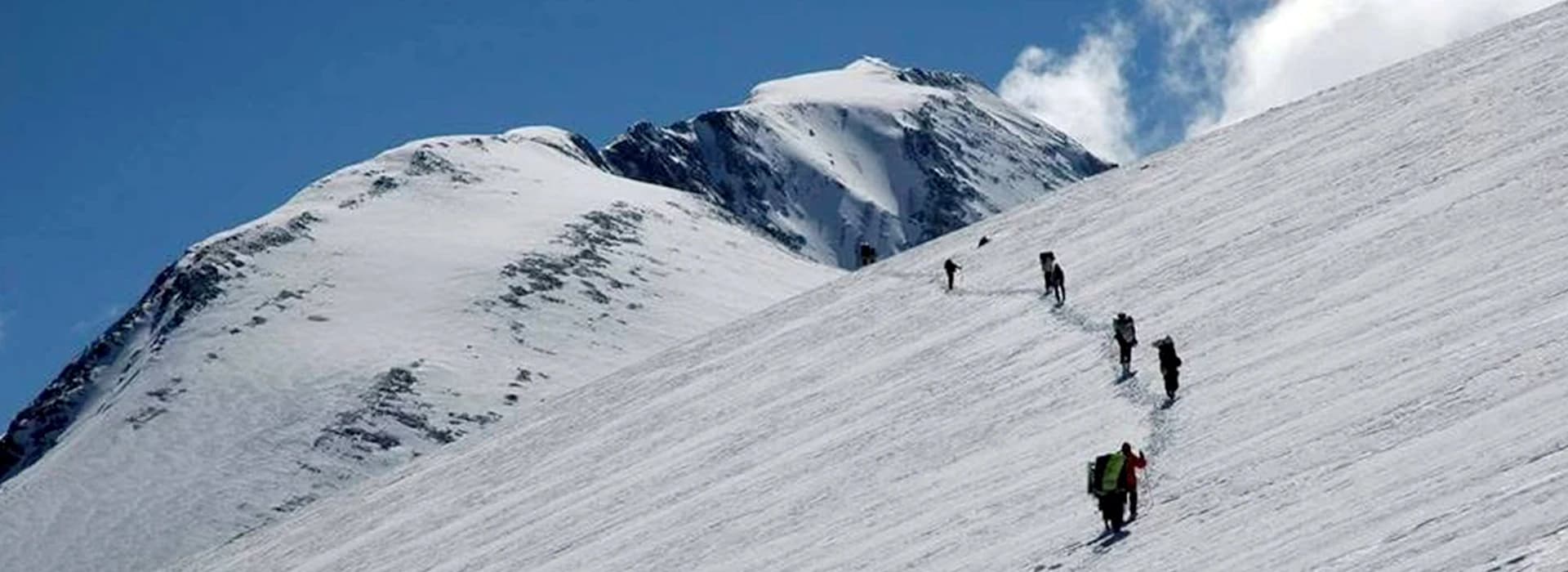The most popular 7000-meter peaks to climb in Nepal, perfect for experienced trekkers seeking thrilling high-altitude mountaineering adventures.
Popular 7000 Meter Peaks to Climb in Nepal
Tourism in Nepal offers you a different experience than in any corner of the world, and it is often known as the home of the Himalayas because most of this mountain range is located in the country.
As per the new law announced by Nepal's government, to climb Mt. Everest (8,848.86 m/29,032 ft), you'll now need an official summit certificate issued by the Department of Tourism for climbing either of the Nepalese mountains that are allowed to ascend over 7,000 m.
Today, in this blog, you'll learn about the new rule in-depth and the popular 7,000-meter peaks to climb in Nepal.
If you're aiming to become a mountaineer in the coming days or have a dream to climb Everest shortly, then now, you should be aware of this new rule and the purpose of making mountaineering activity in Nepal more strict.
But hang on, just because I used the word 'strict' here, don't be that worried and stop dreaming of reaching the summit of the world's highest point one day.
One thing I can say to you is no matter how strict the rule is, you can still go with the flow and succeed in your mission if you're highly dedicated, disciplined, and loyal to your dream.
My purpose here is to make you aware of the well-known peaks that are at least 7,000 m (22966 ft) high and are eligible to climb, granting you the open way to Everest (Sagarmatha in Nepali).
Popular 7,000 Meter Peaks to Climb in Nepal: Location, Difficulty, Best Season, and Required Permit
Speaking of the peaks over 7,000 m in Nepal, there are several beautiful peaks of such height available here; however, not all are permitted by the country's government or thoroughly suitable to climb.
Anyway, I've prepared a list of some of the best 7,000 m peaks that are fit to climb, in order to prepare for the Everest expedition later in the near future.
Below is the list of 7000m peaks for you with their difficulty level, best season, required permit, and history in the table:
|
Peak |
Altitude |
Location |
Difficulty Level |
Best Season |
Permit |
First Ascent |
Estimated Cost |
|
Himlung Himal |
7,126 m (23379.27 ft) |
Nar Phu Valley, Manang, Manaslu Region |
Moderate |
Spring (April to May), Autumn (Octorber to November) |
Annapurna Conservation Area Permit (ACAP), Trekkers' Information Management System (TIMS), and Himlung Climbing |
By a Japanese Expedition Team in 1992. |
Approximately USD 6,000 to 9,555 per person |
|
Baruntse |
7,129 m (23389.11 ft) |
Sankhuwasabha,Makalu-Barun Region |
Moderate |
Spring (April to May), Autumn (October to November) |
Makalu-Barun National Park Permit, TIMS, and Baruntse Climbing Permit |
By the members of the New Zealander Team: Colin Todd and Geoff Harrow in 1954. |
Approximately USD 7,000 per person |
|
Tilicho Peak |
7,134 m (23406 ft) |
Manang, Annapurna Region |
Challenging |
Autumn (September to November) |
ACAP, TIMS, and Tilicho Climbing Permit |
By a French expedition team in 1978 |
Approximately USD 9,000 to 12,000 |
|
Putha Hiunchuli (Dhaulagiri VII) |
7,246 m (23773 ft) |
Dhaulagiri Region |
Moderate |
Spring (April to May), Autumn (October to November) |
Dhaulagiri Conservation Area, TIMS, and Putha Hiunchuli Climbing Permit |
By a joint Nepalese-Swiss expedition: J.O.M Roberts and Ang Nyima Sherpa team in 1954. |
Approximately USD 6,100 to 12,500 per person |
|
Annapurna IV |
7,525 m (24688.32 ft) |
Gandaki Province, Annapurna Region |
Challenging |
Spring (April to May), Autumn (Octorber to November) |
ACAP, TIMS, and Annapurna IV Climbing Permit |
By a German expedition team in 1955 |
Approximately USD 9,999 per person |
Significant Factors For Goal-Oriented Mountaineers
To climb either of these mountains, you'll be required to obtain the above-mentioned permits accordingly. The permit usually includes a peak climbing permit, a protected or conservation area permit, and a TIMS card. To get these permits, you should contact the local trekking agencies.
Spring (April to May) and Autumn (September to November) have generally stable weather with mild temperatures, clear skies, and a lesser chance of avalanche, making your high-elevation journey convenient.
Himlung Himal, Baruntse, and Putha Hiunchuli are considered moderately difficult. These peaks are suitable for first-timers. On the other hand, Tilicho Peak and Annapurna IV are challenging mountains. Therefore, for this two-peaks expedition, climbers should take advanced mountaineering training.
For the expedition of any of these peaks, proper training and preparation, experienced guides, and staff are critical.
Why Nepal’s Government Made This Rule?
As we all know now, aspiring Everest climbers must climb a peak that is over 7,000 m first. Most of you might be uneasy with the new law, as you'll need to invest even more to climb Everest.
While some might think it's the right decision from the government.
The expense of the Everest expedition is already in place, but now, you are also required to invest in a peak of at least 7,000 m or else you aren't eligible to climb the summit of your dream peak.
However, if you keep the climbing expenses aside for a while and think deeply, you'll find that the new rule also has some positive points for both Nepal and mountaineers.
The country didn't make the Everest expedition strict for no reason. The main purposes of the government in making this rule are as follows:
Systematic Climbing Advancement
Everest climbing has become so common in recent days. Before, it was like, you know, taking a few months of advanced peak climbing in Nepal training gives you a ticket to the summit of the world's highest peak directly.
More than 1,000 tourists used to visit Nepal every year for the Everest expedition.
Some of them were experienced climbers, while others ain't but just with a dream to set foot on the highest point on the planet.
Not only Sagarmatha, but any mountain in Nepal is challenging and not an easy game to play.
For success in any sector, you need to advance gradually or step by step. Everything should go systematically.
To search for a shortcut or direct success might lead you to failure instead and cost you a lot.
In the case of mountain climbing, especially Mt. Everest, it's better not to rush and take shortcuts, as slow and steady always wins.
As a result, just taking advanced climbing training isn't enough to summit the world's highest peak safely and successfully.
You also need experience because your knowledge would mean nothing if you haven't used your skills yet.
You know what, you shouldn't pray for the easy way out, but pray for the strength and patience to finish the tough journey.
Accordingly, trust the process; this new regulation will really assist you in making your high-altitude experience professional.
Minimise Safety Concerns
One of the main purposes of Nepal's government to implement the new law for aspiring Everest climbers.
On average, it's found that 5 to 10 climbers die each year during the Everest expedition, especially near the summit.
Traffic on the summit is one of the major reasons for facing this problem each year. Before, it was all about having advanced mountaineering training and paying fees to climb Sagarmatha was enough for the mission.
No experience was required, which caused an influx of mountaineers on the summit.
To climb Mount Everest to an experienced climber isn't a thing to worry about.
However, when it comes to an inexperienced individual, it's something that we should be very concerned about.
No matter how advanced the training class they take, if it's their first time, then the safety concerns arise there.
Many first-timers were found dead in recent times, and in order to save them, several mountain guides also lost their lives in the action.
Thus, to reduce safety concerns in the Everest summit, the new strict rules and regulations have been implemented. It'll help minimise the number of beginners in the dead zone.
Waste Management At The Base Camp
Due to the overflow of climbers at the Everest Base Camp (EBC), the entire area has recently turned into a dumping site.
No matter how much the climbing team tried to clean their waste after finishing the mission, it never worked out as expected, and global warming is rising day by day.
It is causing ice and glaciers to melt, making the peaks look naked even in the winter season.
To control the waste, it's vital to manage the tourist flow first.
Without doing so, it is almost impossible to address the issue of global warming in the Himalayas.
Furthermore, as per the new rule, climbers are responsible for bringing their waste down from the EBC by themselves.
Promote Other Peaks
Nepal rest exactly on the lap of the Great Himalaya, which is why many stunning mountains lie here in the country.
Yet, Mount Everest and some other 8,000-meter peaks like Annapurna I (8,091 m/26545.28 ft), Kanchenjunga (8,586 m/28,169 ft), etc., are only recognised in the world.
Many other mountains below 8,000 m in Nepal are also worth viewing and climbing, which fewer people know about.
And the country can't just rely on Everest or other peaks over 8,000 m when it already has several mountains available that are best for adventure activities and sightseeing, such as Annapurna VI, Himlung Himal, Tilicho Peak, etc.
It's now time for them to rise and get recognised globally. On the other hand, people around the world also need to know how much Nepal can offer them besides Sagarmatha, as the Himalayan Range isn't only about a single mountain that stands at the top of the world.

Permit Requirements And Climbing Rules
This is a basic outline of permit requirements and climbing regulations for five prominent 7,000 m peaks in Nepal: Himlung Himal, Baruntse, Tilicho Peak, Putha Hiunchuli, and Annapurna IV.
The information is divided into three main sections:
Climbing Permits And Government Costs
All of the above peaks require a climbing permit issued by the Nepalese Government. This permit can be different for every mountain and also depends on the season.
Himlung Himal: Permit fee varies based on season and number of climbs
Baruntse: Between $400-600 in spring, $200-300 in autumn, or $120-135 in winter/summer
Tilicho Peak: Between $450-600 in spring, $200-300 in autumn, or $120-130 in winter/summer
Putha Hiunchuli: $450-650 in spring, $200-300 in autumn, or $120-130 in winter/summer
Annapurna IV: $500-700 in spring, $200-400 in autumn, or $100-200 in winter/summer
Needed Papers And Procedure
To apply for a permit for these peaks, you'll be required to submit your necessary documents:
passport, passport-size photo, and travel insurance, to your preferred local trekking agency because you aren't allowed to go on an expedition on your own.
You must go through the agency.
Doing so will make your journey even more comfortable and hassle-free. They'll do all of your paperwork, giving you enough time to take a rest and prepare for a peak climbing mission.
One of the best trekking agencies in Nepal is Ammonite Adventure.
We've been doing this work successfully for more than a decade and have experts for documentation and mount climbing.
What I can promise you is that we'll be your true adventure companion.
Note: Travel insurance must be purchased through your country's local insurance company that covers the policy: mountaineering, heli rescue, medical treatments for altitude sickness, and other emergencies. It isn't valid if you buy insurance in Nepal. And remember to read the policy once you obtain insurance to ensure it meets all the requirements needed for expedition.
How To Choose the Right Peak Over 7,000 m To Prepare For The Everest Summit?
As I've already mentioned, the best above 7000-meter peaks to climb in Nepal in the previous section in the table, you can now easily check the details by yourself.
From there, you can choose either of the mountains for your future climbing mission by considering their elevation, difficulty level, location, and estimated cost.
It's all up to you, which peak you want to climb and open the door to Everest by yourself. Believe me, all of them are exceptional.
There will be no regret later in climbing any of the peaks from the table if you're well-prepared, trained, and dedicated towards your dream.
What I can advise you for now is that if you have not been to the mountainside and are planning to taste the altitude for the first time, then choose only that peak from the table which is not technically demanding. It ain't mandatory for you to choose the tough one.
All you need is to have an official climbing certificate to get a permit to climb Mt. Everest shortly.






